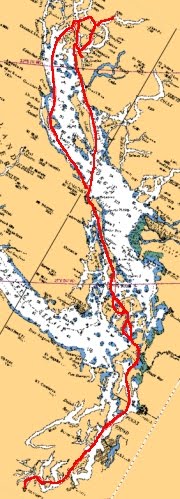 |
| Rainy & cold at anchor in Mereworth Sound |
Ready? Let's get started... Chop the bacon into quarter inch or so pieces. Heat your pot over medium-high heat and fry the bacon until just barely crisp, or to how you like it. Remove the bacon from the pot, along with most of the grease leaving about one tablespoon of grease in the pot. Turn down the heat to medium.
Next add one tablespoon each of the onion, garlic powders to the pot and stir them about for about one minute. If you have a quarter teaspoon of red pepper flakes add this now. If you are using fresh onion and garlic, cook until the onion is soft then add the garlic. Do not burn your onion and garlic whether fresh or dried! Ooh the boat is smelling even better now. Anticipation for supper is rising.
Next add the chicken broth (either canned or using bullion cubes already mixed with water), canned tomatoes, quarter cup red wine, Italian seasoning (1 1/2 t or 1 t of oregano and 1/2 t of basil), half of the bacon, and three cups of water to the pot (I simply use the empty chicken broth can, fill it with water, and put two cans of water in). Increase the heat and get the mix to a boil. When boiling add a good two inch grab of dried spaghetti noodles to the pot. Mix the noodles well into the pot. Now, turn down the heat to low, cover the pot, and let the noodles cook for about 12 minutes. Enjoy a glass of wine while you wait. Stir the noodles occasionally while cooking to ensure there are no clumps and that they are cooking evenly. When the noodles are cooked but still slightly chewy (al dente) remove the pot from the heat.
 Next, add half of a block (about four ounces) of cream cheese and a good measure, if you have it, of Parmesan cheese. Mix the cheeses well with the noodles, cover, and let the pot sit for five minutes. This will thicken up the sauce. Finally add the other half of the bacon to the pot along with some dried parsley and serve. Viola! You have a good creamy, comforting, tomato and bacon spaghetti that only used one pot. Kids and adults love the taste and the easy clean up too.
Next, add half of a block (about four ounces) of cream cheese and a good measure, if you have it, of Parmesan cheese. Mix the cheeses well with the noodles, cover, and let the pot sit for five minutes. This will thicken up the sauce. Finally add the other half of the bacon to the pot along with some dried parsley and serve. Viola! You have a good creamy, comforting, tomato and bacon spaghetti that only used one pot. Kids and adults love the taste and the easy clean up too.We've enjoyed this recipe so much that we have experimented by adding prawns, left over grilled salmon, or even smoked salmon to this dish too. All of these "experiments" were hits with this recipe. When using cooked prawns, salmon, or smoked salmon make sure you add them when you add the cream cheese to the noodles. Hmm? I bet it would taste good with clams or mussels too. Again, I would add them when adding the cream cheese to the noodles. If you add the seafood too soon it would end up over-cooked. Another time, to "dress it up" I topped the spaghetti off with some chopped sun dried tomatoes which added an extra special taste. Enjoy!
Here's the full recipe in recipe form:
One-pot Boat Creamy Bacon Spaghetti
Ingredients:
Instructions:
- 5 strips (or more) bacon
- 1 T onion powder -or- 1 onion, diced
- 1 T garlic powder -or- 5 cloves of garlic, crushed
- 1/2 teaspoon crushed red pepper flakes (optional)
- 1/4 cup red wine
- 1 can Italian style diced tomatoes, or diced tomatoes
- 1 1/2 t Italian seasoning -or- 1 t dried oregano & 1/2 t dried basil
- 1 can chicken broth -or- 2 chicken bullion cubes in 1 1/2 C water
- 3 cups water
- 2" diameter "grab" of dry linguine or spaghetti
- 1/4 cup grated Parmesan cheese
- 4 ounces (half of an 8 ounce brick) cream cheese cut into chunks
- 1 t dried fresh parsley
Cut the bacon into 1/4-inch pieces and cook in a pot over medium heat, stirring to separate the bacon into pieces. Cook until bacon to your desired doness, then remove to a paper towel lined plate.
Drain all but 1 tablespoon of the bacon fat from the pot and reduce the heat to low. Add the dried onion, garlic and crushed red pepper flakes, and cook, stirring frequently, for about 1 minute. Don't burn it! If you are using fresh onions, cook for 5 minutes or until the onions are translucent and soft.
Pour in the chicken broth, water, canned tomatoes, Italian seasoning and half of the reserved bacon to the pot. Increase heat to medium high, and bring the mixture to a boil. When it is fully boiling, add in the noodles, cover, reduce the heat to low, and simmer for about 10-12 minutes, stirring frequently, or until the noodles are soft but chewy (al dente). Remove the pot from the heat.
Next stir in the grated Parmesan cheese and the cubed cream cheese, cover again and let stand for 5 minutes. When the 5 minutes are up, stir well to mix the noodles in the sauce. The melted cream cheese will thicken the sauce.
Serve with the remaining bacon and parsley on top.


